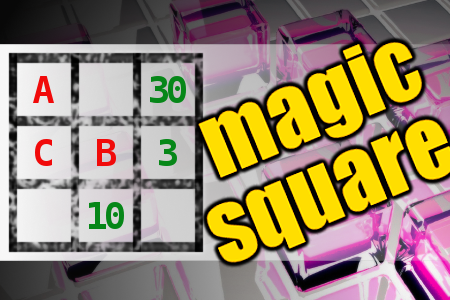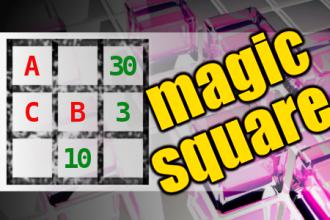MAGIC SQUARE: Calculate A+B+C
The aim is to place the some numbers from the list (2, 3, 4, 5, 10, 12, 22, 23, 30, 47) into the empty squares and squares marked with A, B an C. Sum of each row and column should be equal. All the numbers of the magic square must be different. Find values for A, B, and C. Solution is A+B+C.Correct answers: 33
The first user who solved this task is Roxana zavari.
#brainteasers #math #magicsquare

The following headlines were a...
The following headlines were actually printed in newspapers. The ironyin some of these are absolutely astonishing, hilariously funny (thoughsometimes awkward). Check them out:
- Never Withhold Herpes Infection from Loved One
- Miners Refuse to Work after Death
- Include Your Children when Baking Cookies
- Enfields Couple Slain; Police Suspect Homicide
- Typhoon Rips Through Cemetery; Hundreds Dead
- Something Went Wrong in Jet Crash, Expert Says
- Police Begin Campaign to Run Down Jaywalkers
- Safety Experts Say School Bus Passengers Should Be Belted
- Drunk Gets Nine Months in Violin Case
- Survivor of Siamese Twins Joins Parents
- Iraqi Head Seeks Arms
- Prostitutes Appeal to Pope
- Panda Mating Fails; Veterinarian Takes Over
- British Left Waffles on Falkland Islands
- Lung Cancer in Women Mushrooms
- Enraged Cow Injures Farmer With Axe
- Plane Too Close to Ground, Crash Probe Told
- Juvenile Court to Try Shooting Defendant
- War Dims Hope for Peace
- Cold Wave Linked to Temperatures
- Deer Kill 17,000
- Stolen Painting Found by Tree
- Chef Throws His Heart into Helping Feed Needy
- Arson Suspect Held in Massachusetts Fire
- Ban On Soliciting Dead in Trotwood
- Local High School Drop-outs Cut in Half
- New Vaccine May Contain Rabies
- Hospitals are Sued by 7 Foot Doctors
- Two Sisters Reunited After 18 Years in Checkout Counter
- Killer Sentenced to Die for Second Time in 10 Years
- Red Tape Holds Up New Bridges
- Man Struck By Lightning Faces Battery Charge
- New Study of Obesity Looks for Larger Test Group
- Astronaut Takes Blame for Gas in Spacecraft
- Kids Make Nutritious Snacks
- Eye Drops Off Shelf
- Teachers Strike Idle Kids
- Clinton Wins on Budget, But More Lies Ahead
- Princess Diana Was Alive Hours Before She Died
- Never Withhold Herpes Infection from Loved One
- Miners Refuse to Work after Death
- Include Your Children when Baking Cookies
- Enfields Couple Slain; Police Suspect Homicide
- Typhoon Rips Through Cemetery; Hundreds Dead
- Something Went Wrong in Jet Crash, Expert Says
- Police Begin Campaign to Run Down Jaywalkers
- Safety Experts Say School Bus Passengers Should Be Belted
- Drunk Gets Nine Months in Violin Case
- Survivor of Siamese Twins Joins Parents
- Iraqi Head Seeks Arms
- Prostitutes Appeal to Pope
- Panda Mating Fails; Veterinarian Takes Over
- British Left Waffles on Falkland Islands
- Lung Cancer in Women Mushrooms
- Enraged Cow Injures Farmer With Axe
- Plane Too Close to Ground, Crash Probe Told
- Juvenile Court to Try Shooting Defendant
- War Dims Hope for Peace
- Cold Wave Linked to Temperatures
- Deer Kill 17,000
- Stolen Painting Found by Tree
- Chef Throws His Heart into Helping Feed Needy
- Arson Suspect Held in Massachusetts Fire
- Ban On Soliciting Dead in Trotwood
- Local High School Drop-outs Cut in Half
- New Vaccine May Contain Rabies
- Hospitals are Sued by 7 Foot Doctors
- Two Sisters Reunited After 18 Years in Checkout Counter
- Killer Sentenced to Die for Second Time in 10 Years
- Red Tape Holds Up New Bridges
- Man Struck By Lightning Faces Battery Charge
- New Study of Obesity Looks for Larger Test Group
- Astronaut Takes Blame for Gas in Spacecraft
- Kids Make Nutritious Snacks
- Eye Drops Off Shelf
- Teachers Strike Idle Kids
- Clinton Wins on Budget, But More Lies Ahead
- Princess Diana Was Alive Hours Before She Died

